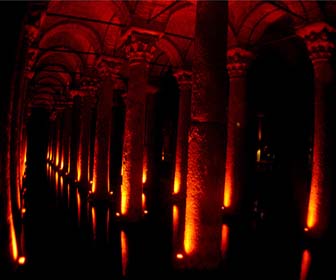 |
 |
| |
|
| |
YEREBATAN SARAYI | Basilica Cistern. The Palace that was once forgotten.

|
| |
|
|
|
| |

|
Yerebatan Sarayi means as the Sunken Palace. This is the grandest
underground cistern that showcases the remains of the Romans. Now,
this is one of the major attractions in Turkey.
Yerebatan Sarayi has a vast underground storage tank built by
Constantine the Great during the 4th century. And in the 6th
century, it was expanded by Justinian. For most of the Ottomans, the
cistern only served as a well and a fishing hole for the locals
which are now the Sultan Ahmet.
In 1453, the cistern was mostly taken for granted after the fall of
the Byzantine Empire. It became a muddy hollow ruin until it was
cleaned up and opened to the public in 1987.
|
|
| |
|
|
| |
|
|
| |
The cistern is now a must
see tourist attractions that offers a cool let-up from the
Istanbul’s sweltering summer heat. The beating lights, water
drenching from the ceiling and the strange music played on a very
well placed speakers tote up an air of mystery to the place. Here,
you can see 336 columns and approximately 12 inches of water on the
floor.
Many of these columns were mismatched and look to have been pinched
from elsewhere. Wooden planks are placed so that the visitors can
walk among the columns because of some of which are very pleasing to
the eye due to its decoration carved on it. One of the famous sights
in the cistern is the pedestal with two Medusa heads engraved into
it. One of the heads is on its side while the other one is inverted.
The purpose of these heads that give supports to the columns on the
north side of the cistern is still a mystery.
Yerebatan Sarayi is a cathedral sized underground cistern which is
143 by 65 meters and it is capable of holding up to 80,000 cubic
meters of water. The huge space was broken up by 336 marble columns
each is 9 meters in height. Two of these columns based on a recycled
blocks carved with the head of Medusa. Another well known supporting
pillars found in the cistern is the column of tears because it has
been carved with symbols similar to tears.
You can also find ad hoc ponds of goldfish throughout the cistern
that keeps the water clean and aerated.
The cistern is situated on the historical peninsula of Istanbul that
was surrounded by a firebrick wall and covered with a special mortar
providing insulation against water. The water coming from the
cistern was supplied from the Belgrade Woods which rest about 19km
north of the city through canals constructed by Emperor Justinianus.
The water from the cistern is collected rain water.
Istanbul is one of the most often hemmed cities in the world that
needs a stable supply of water thus; many underground cisterns were
built during the Byzantine Empire. Water from these cisterns was
brought from far away sources through aqueducts. Some of these
cisterns were not used properly because some of the Turks now
preferred to use fresh running water after capturing the city from
the Byzantines. Most of these cisterns turned into bazaars or store
houses but the Yerebatan Sarayi remains its beauty and grandness.
Yerebatan is located in
Sultan Ahmet Square, at the end of
northeastern of Hippodrome and across the street of the
Hagia
Sophia. Your tour in the cistern can take from 30 minutes up to an
hour and there’s a minimal admission fee. And if you are not in a
hurry, you can stay and relax while sipping a cup of apple tea from
a tulip shape cup in a small café that provides a pleasant and
peaceful spot amid in the hustle and bustle of Istanbul.
The simple and plain entrance of the Yerabatan Sarayi gives the lie
to the wonders that you can find beneath the cistern. The mystery of
the Sunken Palace gives its visitors excitement discoveries of its
grace encircled with ancient and relapsing city walls. The place is
filled with infectious vibrant energy and mystery under the surface
of the modern city. This place should be on your lists in places
that you must not forget to visit when you are in Istanbul.
|
|
| |
|
|
| |
|
|
| |
|
<-Back
|
|
|
 |
|
